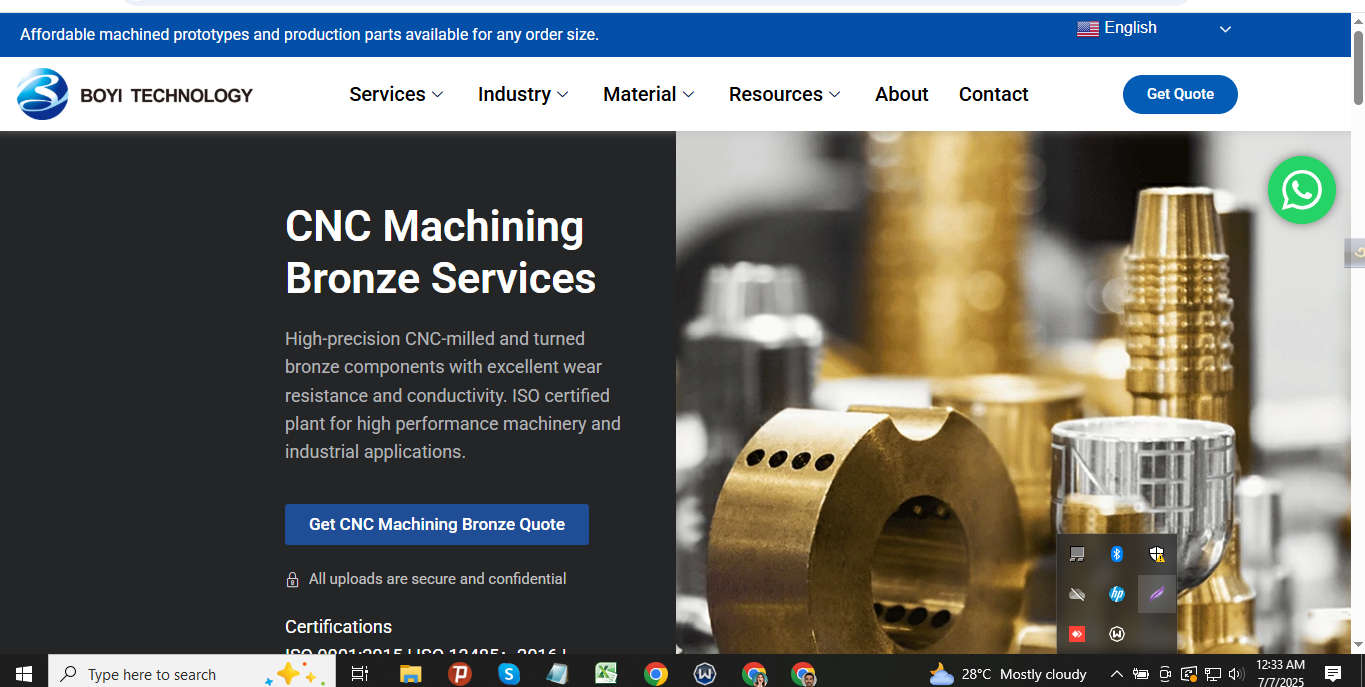CNC Machining Bronze

CNC Machining Bronze: From Material to Masterpiece
What Is Bronze?
Bronze, a time-honored alloy primarily composed of copper and tin, has been revered for centuries for its strength, beauty, and versatility. Over time, the composition of bronze has evolved, often incorporating elements such as aluminum, silicon, phosphorus, or lead to enhance specific characteristics. These variations allow bronze to serve a diverse range of applications, from artistic sculptures to industrial-grade components.
Why Use CNC Machining for Bronze?
One of the key reasons manufacturers turn to CNC (Computer Numerical Control) machining for working with bronze is its balance of machinability and strength. Bronze is generally easier to machine than other metals like stainless steel or titanium. This property, combined with its excellent wear resistance and dimensional stability, makes it ideal for components that must perform reliably under stress—such as bushings, bearings, gears, and marine hardware. Moreover, bronze’s natural corrosion resistance and visual appeal make it especially desirable for products that must be both functional and attractive.
Types of Bronze Alloys and Their Benefits
When machining bronze, different alloys bring distinct benefits. Phosphor bronze, for example, is prized for its fatigue resistance and low friction, making it perfect for electrical connectors and springs. Aluminum bronze offers superior corrosion resistance, even in saltwater environments, which is why it is often used in marine equipment. Leaded bronze, on the other hand, includes lead to provide natural lubricity, simplifying the machining process and extending the life of both tools and parts.
CNC Machining Techniques for Bronze
CNC machining processes for bronze typically involve turning, milling, drilling, and occasionally more advanced techniques like electrical discharge machining (EDM). Milling and turning are the most frequently employed operations, enabling the production of high-precision components with tight tolerances. Bronze’s relatively soft nature means it can be cut cleanly with carbide or high-speed steel tools, although certain alloys—especially aluminum bronze—may require more durable, coated tooling to prevent wear.
Machining Best Practices
To ensure quality results, machinists often apply best practices tailored to bronze’s characteristics. Cooling and lubrication are essential, particularly when working with harder variants, to maintain surface finish and prevent tool degradation. Chip control can also be a challenge, as bronze tends to produce fine, stringy chips that cling to tools and workpieces. Proper tool geometry and machine setup help mitigate these issues, while post-machining finishing—such as polishing or coating—enhances both aesthetics and corrosion resistance.
Challenges and Considerations
While bronze offers many advantages, it also comes with certain trade-offs. Its cost can be higher compared to aluminum or basic steel alloys, and it may require more frequent cleanup during machining due to chip buildup. Additionally, temperature management is crucial since bronze expands with heat, which can affect dimensional accuracy if not carefully controlled.
Common Applications of CNC-Machined Bronze
In practical applications, bronze components are found across a wide spectrum of industries. Marine equipment benefits from bronze’s resistance to corrosion and biofouling. In heavy machinery, its wear resistance extends the lifespan of bearings and bushings. The electrical sector uses bronze for its conductivity and low contact resistance, while designers and sculptors appreciate its aesthetic appeal and aging patina.
Choosing the Right CNC Machining Partner
Choosing the right machining partner is important when working with bronze. Experienced CNC service providers understand the subtle differences between alloys and can recommend the best one for your application. They also have the proper equipment and knowledge to maintain tight tolerances and deliver consistent quality across small or large production runs.
Conclusion
In conclusion, CNC machining of bronze merges tradition with modern precision. With its ideal blend of mechanical strength, corrosion resistance, and machinability, bronze remains a top-tier material for both industrial and artistic applications. Whether producing marine parts, electrical contacts, or decorative pieces, CNC-machined bronze components exemplify durability and craftsmanship at their finest.
- Art
- Causes
- Crafts
- Dance
- Drinks
- Film
- Fitness
- Food
- Jogos
- Gardening
- Health
- Início
- Literature
- Music
- Networking
- Outro
- Party
- Religion
- Shopping
- Sports
- Theater
- Wellness
- Script
- App
